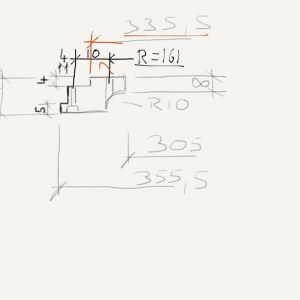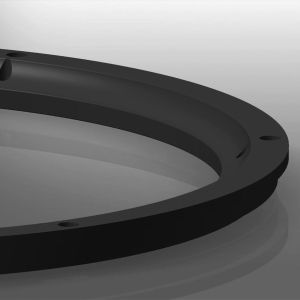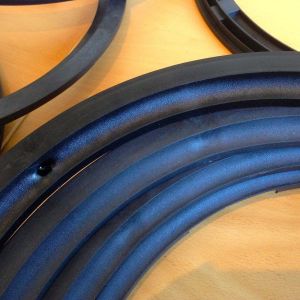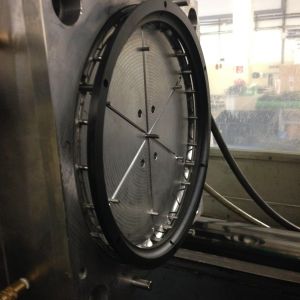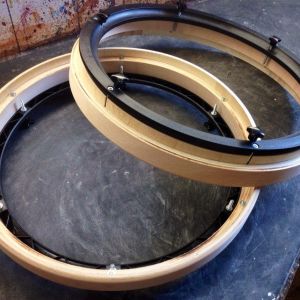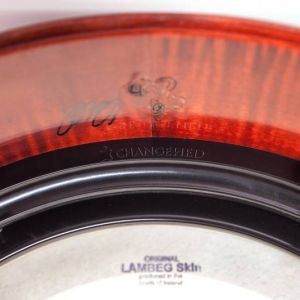The CHangeHED System

CHangeHED
The CHangeHED skin holding system allows to easily change the head and the tuning rim of the drum. This opens a lot of new possibilities:
Try out other heads and tuning frames with different sound characteristics on the same drum?
A synthetic head for the outdoor gig
Christian Hedwitschak offers a great variety of tuning rims and skin types on his website, which all fit on the ChangeHED system. These offer a lot more future possibilities for all customers.
- CHangeHED players can swap skins with other CHangeHED players. “Spine line in the center of the skin, at 2/3, at the edge, or rather no spine in the skin at all? How does DRAGONSkin®classic sound compared to DRAGONSkin®spicy? Should I try a TwinSkin? How does a deer DRAGONSkin® sound? How different does my favourite skin sound when I use a compressor tuning frame instead of the standard comfort rim?” Try it out and take your time in finding out what works best for you! :)
- The nail / ribbon design is not attached to the main frame any longer, but to the drum skin!
- So you can get, for example, a DRAGONSkin®spicy with a red ribbon and silver nails for a RWE main frame, an additional spare deer skin without decorative nails, another EdlauerSelect spare skin just taped without decorative nails, another spare TwinSkin skin with a black nylon ribbon, and another transparent synthetic spare skin with a black nylon ribbon. These are only a few ideas, there are a lot more possibilities.
- You can now use a synthetic skin for playing open-air gigs in bad weather and change back to your favourite natural skin afterwards.
- Bodhrán teachers can choose a transparent synthetic skin for a better demonstration of left/right hand coordination, and go back to the natural skin after class.
- You can now get a new main frame for your favourite skin – we offer custom-made frames in practically all variants, even concave frames!
- You now have the option to take a spare skin with you when going on tour.
- Customers around the world can now save money for shipping fees and customs clearance by being able to mount the skin themselves without having to send in the entire drum for repair.
"During the Craiceann bodhrán summer school on Inis Oírr in June 2013 I presented the ChangeHED skin holding system.
For me, this skin holding system that offers the possibility to replace both the drum skin and the tuning frame, is the result of all of my developments and all my experience of the past 12 years.
For its standard fixed diameter of 37 cm, the ChangeHED certainly can’t meet all customer demands, and to a certain extent, the sound possibilities are limited. That’s why it goes without saying that I’ll continue making custom-made drums and, of course, Signature Lines.
However, the ChangeHED system offers great advantages for beginners and advanced players, and it helps them with their individual progress. The drum can be adjusted to your way of playing, your sound preferences and playing situations.
Like a chameleon, the drum changes and adapts to its environment.
Another huge advantage of the ChangeHED system is that you can use it as a developer tool. For example, tuning frames can be reworked and retested with the same skin as often as required. Different skins can be tested on the same tuning frame, offering unique and new possibilities to instrument makers.
ChangeHED is more than just a drum.
ChangeHED is a drum system – a system with components that can be flexibly combined and replaced, at any place and with parts from any manufacturer."
You can order the following options directly in our shop:
- The compressor tuning system. It perfectly fits with the Lambeg skin and comes close to my ideal sound, as it makes the sound drier and more defined.
- The RWE Genuine lambeg skin for the CHangeHED system, which is also used on my signature line bodhrán.
In addition, Christian Hedwitschak's website offers the following options:
Tuning frame profiles
Different tuning frame profiles with individual bearing edge designs influence the sound of each and every individual drum skin.
- For synthetic skins, there is a special tuning frame with cotton-covered bearing edge that makes the skin a bit more “natural” without making it lax or imprecise.
- The “Bassmonster” tuning rim with a thick chamois leather-covered bearing edge and a large rounded profile interior gets the maximum of long vibrating, warm and rich base sounds out of every drum skin.
- Tuning rims with chamois leather-covered bearing edge prevent squeaking when using soft, flexible skins and increase tuning stability.
- The Comfort frame without chamois leather-covered bearing edge helps to reach the highest possible brilliance when using harder skins (softer skins may start to produce squeaking sounds).
Drum skins
Different drum skins not only have different sound characteristics. They also feel differently when playing, and they react differently to climatic conditions. The following skins are currently available for the ChangeHED system:
- Our popular EdlauerSelect in different thicknesses, with our without spine line, goat skin. Other skins, e.g. deer, calf or horse available upon request..
- DRAGONSkin® in the design variants velvet, classic, spicy.
- Synthetic skins. These skins are almost immune to climatic changes. Sound-wise, we’ve had the best results using REMO Skyntone®; and Fiberskin3. We offer transparent variants for teaching purposes.
- TwinSkin is available in all possible and impossible combinations ;). Skin rings, stripes and patches between both skins are no problem.
- We also offer just the uncovered holding frames, giving you the option to mount the skin yourself or have another drum maker mount it.
Transport and storage frame
This is a simple wooden ring with the same diameter as the tuning rim. The transport frame is used for additional drumheads that are not mounted on a drum. The frame is clamped into the drumskin using 6 screws (same allen key as for ChangeHED) and their angle supports. We recommend using this frame for transporting and storing the drumskin to protect it from deformation and damage. Some drumskins tend to deform after a while when they’re not regularly tightened. Using the angles, the transport and storage frame is mounted approximately midway between the fixing holes (low skin tension!). This prevents the deformation of the drumskin. The transport frames are deliberately designed for simplicity and cost effectiveness and are not suited for high skin tension. Their sole purpose is to keep the drumskin in shape.
Why does ChangeHED look the way it looks? What are the maker’s intentions behind it? Couldn’t you have built it differently?
Of course, a skin holding system could’ve looked or even worked entirely different; and there are other skin holding systems for other drums, e.g. for drum kits. However, ChangeHED is the result of more than ten years of bodhrán making. Bodhráns are frame drums with the skin on one side, and the sound is modulated using the “skin hand”, while the player holds the outer frame. This clearly distinguishes the bodhrán from e.g. drum kits, where the drums can vibrate freely, and where the outer frame’s influence on the overall sound is much greater than it’s the case with bodhráns, where the tuning frame plays a far more important role. Drums for drum kits don’t have tuning frames as such. Instead, the skin is directly attached to the outer frame. In fact, the tuning frame as a sound-modifying element of the sound system turns the modern type of bodhrán into something truly special. The tuning frame is more than just the skin bearing edge – it’s an independent component, and its characteristics (material, stiffness, profile cross-section, bearing edge, surface properties) have a massive influence on the overall sound of the instrument.
The ChangeHED skin holding system is based on exactly this knowledge.
Why don’t you take the common drum kit skin system with aluminum frames as a basis?
Because I wanted to create a skin holding system specifically for bodhráns. Although synthetic skins are now also used for bodhráns, natural skins are still the most popular choice. I wanted to develop a system that can be used for both natural AND synthetic skins. Die drum skin form at the edge of the aluminium frame system is unsuitable for most natural skins, because natural skins need more tuning space and a larger supporting surface. My intention was to adjust the skin holding system to the bodhrán, and not the other way around :)
Why are the fixing screws (the small Allen screws) behind the tuning screws, and not between them, which would be handier for assembly?
Because the grip between skin frame and main frame must be the strongest where the tuning frame exerts the highest pressure to the skin. Apart from that, I wanted the ChangeHED to be as unobtrusive as possible.
Why didn’t you go for a system that doesn’t require tools?
After using twist / bayonet fastening for the SR Bodhrán, I deliberately opted for the Allen screw system. Not because it wouldn’t work, but because it doesn’t fit in with the overall ChangeHED concept.
ChangeHED and changeable skins are no MUST-HAVES; they’re nice to have. Every drum skin needs a certain amount of time to adjust to the rest of the drum. Depending on the type of skin, this can take several minutes, or even several days.
It is not the purpose of the skin holding system to change the skin as fast and as often as possible, but to provide a reliable, permanent, strong and unobtrusive connection of the skin frame.
Why is ChangeHED only available for 37cm / 15"?
37cm is the most universal size. Most skins and most tuning frames work with this diameter, and the size suits most players. The diameter is small enough to produce a well-defined sound, and it’s big enough to produce an acceptable volume.
Why does ChangeHED have 6 tuning screws?
Players naturally want as few tuning screws as possible to be able to tune the drum quickly. On the other hand, you need sufficient pressure points and a flexible tuning frame to be able to tune skins as precisely as possible, even skins where tuning is more complicated. With the ChangeHED diameter, six pressure points are ideal for most drum skins and most tuning frames.
Plastic instead of wood? For a high-quality instrument?
Sure, why not? The component at this position in the sound system has only a minor influence on the overall sound, it only transfers the structure-borne sound transmission from the tuning frame to the outer frame. I used to use metal components for this, but many of my colleagues have been using plastic blocks for many years. As regards the sound, there is no reason not to do so.
Even if many players are not aware of it, plastic has been used in bodhráns for a long time: heads of tuning screws, tape, ribbons, varnish, each individual glued joint – these are all synthetic materials.
For me, taking this step is the result of a long decision-making process.
The more you think about the requirements of this component, the more logical the demand for a plastic die-cast part becomes.
Highest precision and reproducibility whilst saving weight and providing good availability.
Some closing words from the maker?
Yes! :)As I said, ChangeHED is no universal remedy to meet every requirement. It’s not a must-have, it’s nice to have. The ChangeHED’s purpose is not to provide an option to change the drum skin several times per day. However, it’s a handy option in many ways.ChangeHED is a very valuable tool for players, makers and developers.
ChangeHED thrives on what we all make of it....and it’s fun! :)


